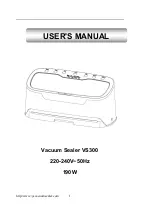
9
Important Instructions
• Do not use damaged or unsuited containers for vacuum packing. Always handle contai-
ners under vacuum with special care. This is crucial to avoid bursting. Do not consume any
food that has been in a damaged container, because splinters could cause severe injuries.
• Only use the designated foils or bags with the appliance. Any other plastic bags will melt on
the sealing band. Leftover plastic on the sealing band damage the sealing band and prevent
the generation of vacuum.
• The appliance is not suited for continuous operation. Please wait after each vacuum
procedure until the appliance has cooled down before starting again.
• When vacuum packing pay attention that no food particles, liquids, or grease are in the
sealing section of the plastic bag or container. The brim of the foil or container must be
smooth and clean. Otherwise no vacuum can be generated.
• For best results do not overfill the plastic bag or containers. Leave about 8 cm free space
(foils) or 3 cm (containers) above the food. Otherwise the appliance cannot generate a
vacuum or liquids or small parts of food can be sucked in (especially if powdery or finely
ground) and damage the vacuum pump. Always work with special care, when vacuum
packing runny food or beverages.
• Pre-freeze moist food before vacuum sealing (1 – 2 hours). This way no liquids can get
sucked into the appliance and the food will not get pressed.
• The lid must be properly closed after inserting the foil to make the appliance ready for
use. You will hear a clicking sound, when the lid snaps shut.
• Only vacuum pack edible foods that are not off and not over-stored. Only use food that is
really fresh! After packing, store foods as usual. The appliance cannot reverse the process
of deterioration, but can slow down the process of decay.






































